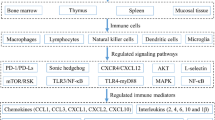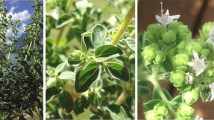Abstract
Immune modulating activity of ethanol extracts from Glycyrrhiza uralensis Fisch was investigated by conserving growth characteristics of several human cell lines. All of the samples did not show severe cytotoxicity on normal human liver cell line, WRL-68, showing less than 25% inhibition of cell growth. The crude extract and its fractionized samples (F1 and F3) inhibited the growth of human hepatoma, Hep3B, down to ca. 70% of normal cell growth in adding 1.0 g l-1 of fraction F3. The result of anticancer experiments was well matched to the results of antimutagenicity using Chinese Hamster Lung cell lines(CHL V79). In adding 1.0 g l-1 of fraction F1, the growth of human B cell was enhanced, up to 60% of control growth. The secretion of two kinds of cytokines, Interleukin-6 and Tumor Necrosis Factor-α from human B cells was also enhanced in adding the crude extract, but not the standards such as Glycyrrhizin (GL) or 18,β-glycyrrhetinic acid (GM). It was found that both of the apoptosis and differentiation were more accelerated in supplementing the crude extract and fraction F1 than in adding the standards. A spot was found only in the crude extract and fractions, not standards by Thin Layer Chromatography(TLC) analysis. It tells that there must be another unknown component in crude and/or fraction F1 as a possible candidate of immune modulators. This component seems to be a derivative of a monomer, GM since its Rf was close to the monomer. It was also interesting that glycyrrhizin, a major component in G. uralensis Fisch was biologically activated by first being hydrolyzed by an enzyme.
Similar content being viewed by others
References
Abe N, Ebina T and Ishida N (1982) Interferon induction by glycyrrhizin and glycyrrhetinic acid inmice.Microbiol Immunol 26:535–539.
Bianxiezu QZ and Huibian QA (eds.) (1992) Natural medicines from plant resources, pp.237, RenminWeishing Press, Shanghai.
Choi JY, Park JS, Yeon ES, Park MH and Hong BH (1998) Effect of Ginsenosides from Panax Ginseng on TNF-α αproduction and T cell proliferation, Yakhak Hoeji 42(3):296–301.
Dargan DJ and Subaka JH (1986) The antiviral activity against herpes simplex virus of the triterpenoid compounds carenoxolone sodium and cycloxolone sodium.J Antimicrobiol Chem18:185–200.
Doll R, Hill ID, Hutton C and Underwood DL (1962) Triterpenoid licorice compound in gastric and duodendal ulcer. Lancet2:793–796.
Doyle A, Griffiths JB and Newell DG (1993) Cell and Tissue Culture: Laboratory Procedures, Wiley, N.Y.
Finney RSH and Somers GF (1959) The anti-inflammatory activity of glycyrrhetic acid and derivatives.J Pharmacol 10:613–620.
Freshney, RI (ed.) (1987) Culture of animal cells. Alan R. Liss, Inc., N.Y.
Fujisawa K, Watanabe Y and Kimura K (1990) Therapeutic approach to chronic active hepatitis with glycyrrhizin. Asian Med J 23: 745–756.
Hiravayashi K, Iwata S, Matsumoto H et al. (1991) Antivial activity of glycyrrhizin and its modified compounds against human immunodeficiency virus type 1 (HIV-1) and herpes simplex virus type 1 (HSV-1) in vitro. Chem Pharm Bull 39:112–115.
Hongshan YU, Yue ZH and Fenxie J (1993) Glucuronide Hydrolysis of Glycyrrhizin by Enzyme to Increasing its Sweetness.Zhongcaoyao 17(5): 10–12.
Kim SK, Kim YG, Lee MK, Han JS, Lee JH and Lee HY (2000) Comparison of biological activity according to extracting solvents of four Acanthopanax root bark. Kor J Med Crop Sci 8: 21–28.
Kim YG, Kim KS, Bang KJ, Hong SY and Lee ST (1998) Growth characteristics, glycyrrhizin and free sugar content of Licorice species. Kor J Med Crop Sci 6:108–113.
Kuroda Y (1996) Bio-mutagenic activity of green tea catechins in Chinese Hamster cells.Mutation Res 361:179–186.
Longchuan C and Armen HT, (1999) Identification of Distinct Signalling Pathways for Somatostatin Receptors SSTR1 and SSTR2 as Revealed by Microphysiometry, Cell Signal 11(7):499–505.
Masanori K and Hiroshi K (1997) Creation of an In VivoCytosensor Using Engineered Mesangial Cells.J Clin Invest 100(6):1394–1399.
Mitsuhiko N, Terawaki K, Ougauri K, Ogihara Y, Yoshimatsu KL and Shimomura KK (1998) Activation of Macropharges by Crude Polysaccharide Fractions Obtained from Shoots of Glycyrrhiza glabraand Hairy Roots of Glycyrrhiza uralensis in Vitro. Biol Pharm Bull 21(10):1110–1112.
Ohtsuki K, Oh-ishi M and Nagata N (1992) The stimulatory and inhibitory effects of glycyrrhizin and a glycyrrhetinic acid derivative on phosphorylation of lipocortin 1 by A-kinase in vitro. Biochem Int 28:1045–1053.
Pompei R, Flore O, Marccials MA, Pani A and Loddo B (1979) Glycyrrhizic acid inhibits virus growth and inactivates virus particles.Nature 281:689–690.
Shiota G, Harada KI, Ishida M, Tomie Y, Okubo M. and Kawaski H. (1999) Inhibition of hepatocellular carcinoma by glycyrrhizin in diethylnitrosamine-treated mice.Carcinogenesis 20:59–63.
Suzuki H, Ohta Y, Takino T, Fujisawa K and Hirayama C (1983) Effects of glycyrrhzin on biochemical tests in patients with chronic hepatitis.Asian Med J 26:423–438.
Wada HG, Owidei JC, Bruncer CH, Miller KR and Parce TW(1992) Measurement of cell response to toxic agents using a silicones microphysiometer. AATEX 1:154–164.
Whyte P and Eisenman RN (1992) Dephosphorylation of the retinoblastoma protein during differentiation of HL-60 cells.Biochem Cell Biol 70:1380–1384.
Yen Y and Guernsey DL (1986) Incresed C-myc RNA leads associated with the precommitment state during HL60 myeloid differentiation.Cancer Res 46:4156–4161.
Author information
Authors and Affiliations
Corresponding author
Rights and permissions
About this article
Cite this article
Chung, W.T., Lee, S.H., Kim, J.D. et al. Effect of the extracts from Glycyrrhiza uralensis Fisch on the growth characteristics of human cell lines: Anti-tumor and immune activation activities. Cytotechnology 37, 55–64 (2001). https://doi.org/10.1023/A:1016111713056
Issue Date:
DOI: https://doi.org/10.1023/A:1016111713056




